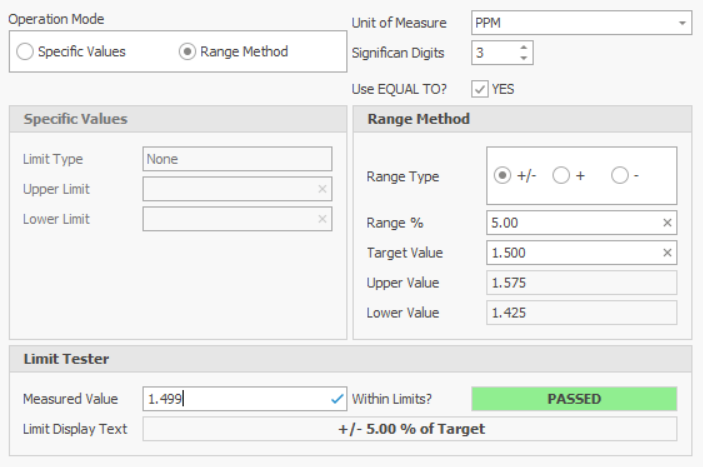TLIMS Limit Set Definition
A Limit Set is a specific configuration for defining the confines of a perceived value. In TLIMS, a Limit Set describes what is most commonly observed as Specifications or Control Limits however TLIMS has specific designations for a Limit Set.

The Limit Set editor supports both Specific Values and Range Values.
Specific Values – will have definitions for Upper and Lower (Between), Upper Only (Max Allowed), Lower Only (Min Allowed).
Range Values – will have definitions for a Target Value and then a Range Percentage value – the limit set is self calculating to determine the upper and lower ranges.

+/- indicates determine if the value range is both upper and lower.
– indicates target to lower value
+ indicates target to upper value
UseEqualTo is a flag that will allow values to be equal to the specified limits.
Specifications vs Control Limits
- Spec Limits, official set specifications to adhere to. Overall limits that designate what is acceptable and unacceptable.
- Control Limits, another level of limits on a product that supports streamlining processes and making them stable.
Commercial vs Process Limits
TLIMS has 2 designations of control limits: Commercial and Process.
- Commercial Limits, a type of control limit set externally (or customer imposed) process limits that may also be enforced.
- Process Limits, a type of control limit calculated and set internally and defined by the actual manufacturing process.
OOS vs OOC Designation
OOS vs. OOC: Out of Spec designates that a final product has violated specification and may be unacceptable to ship, whereas Out of Control designates that a product needs further investigation but could be acceptable.
Ship To Control (S2C)
Ship to Control is a process/program that some clients elect to have notification and approvals when out of control conditions occur. The OOC Approval process allows documentation of the approval/rejection of the final product.
